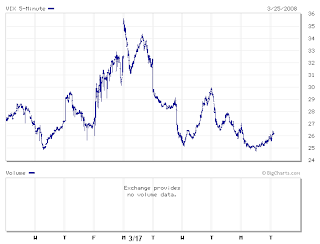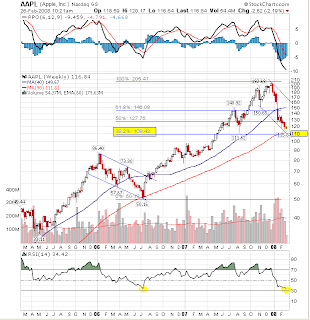

Finding A Friend In The Trend
"The trend is your friend" is an important trading guideline.
Because trends persist for long periods, a position taken with the trend will more likely be successful than one taken randomly or against the trend. Trading with the trend in a bull market means buying on dips; in a bear market, selling on rallies.
On a bar chart, each vertical line connects the day's, week's, or month's high and low. The horizontal tick to the right of the line indicates that time period's closing price.
A trend is easily spotted on a bar chart. An uptrend is a series of higher lows and higher highs. Uptrend lines are drawn under the lows of the market and give support. A downtrend is a series of lower lows and lower highs. Downtrend lines are drawn across the highs and give resistance to the market. The soybean chart shown below has both uptrend lines and a downtrend line.
Lows and highs vs. closes
A trendline can be drawn when two points are available. The more times a trendline is touched, the more technically significant this support or resistance line becomes.
While some chartists draw trendlines through lows and highs, others may prefer drawing lines through closes in hopes of detecting a change in trend more quickly.
Trendlines may change angles, requiring another line drawn through new high or low points. For example, the sideways trading action in March and April broke the steeper uptrend line connecting the Feb. 13 and March 20 lows. But when the uptrend resumed in early May, a more shallow uptrend line can be drawn connecting the February and late-April lows.
The most reliable trendlines are those near a 45° angle. If about four weeks have elapsed between the two connecting points, this increases the trendline's validity. However, steep trendlines that don't fit these guidelines, like the uptrend line in the early portion of the soybean chart, may be just as useful.
Often, minor uptrends or downtrends will confuse the beginner. It may seem the market has turned around. However, sharp chartists will see these minor trends as small ripples within a major wave. Remember, if the trendline isn't broken, that trend remains intact. Two closes outside the trendline are the criteria for detecting a change in trend. However, very seldom do markets go directly from uptrend to downtrend. At the end of a move, traders become less aggressive and prices may swing in a sideways pattern or consolidation period.
Many times, markets break into an uptrend or downtrend out of a sideways trading pattern or consolidation period. In the soybean chart, prices traded in a 50As a general rule, the longer the consolidation period, the greater the rally after the breakout.
Because traders need time to be convinced that they should put their money into the market, sideways patterns are more likely to occur near the bottom of a move. The beginning of a downtrend often will be sharp and sudden as investors pull money out of the market.
False breakouts
Another way beginners might be fooled is seeing false breakouts of tops and bottoms. As prices begin to make their move in switching from a downtrend to an uptrend, traders with short positions will "cover." This buying many times will cause the market to rally above the downtrend line. This short covering rally seldom holds, and prices may drop back to the breakout point. The uptrend is confirmed when prices close above the high of the short rally.
On a topping formation, long liquidation takes prices through the uptrend line on a short break. Before the downtrend begins, the market sometimes rallies back to "test" the uptrend line as shown on the soybean chart in September. As the downtrend unfolds, the second reaction rally could not top the highs of the first rally.
Channel lines are an extension of the trendline theory. The October through January downtrend on the soybean chart shows prices staying in a "channel" between the downtrend line and a line drawn parallel to it, connecting the lows. A channel line in a downtrending market helps identify where support may be found.
Speedlines are another line which show where prices may find support or resistance. Frequently, speedlines and trendlines will overlap, emphasizing that line's importance to the market.
The speedline on the soybean chart starts from the June 29 low. To find the points to connect with the low, divide the range between the low ($6.40) and the high($9.94) into thirds and subtract from the high.
Plot the point obtained by subtracting one-third of the range from the high on the day the high was made. A line drawn between this point ($8.76) and thelow established the 1/3 speedline. The 2/3 speedline is drawn through the point that is two-thirds of the range subtracted from the high ($7.58) plotted on the day the high was made.
Another way to detect a change in trend is by looking for a price from which the market reacts two or three times.
A double bottom, such as the one on the T-Bill chart, indicated the 87.10 to 87.20 area gave support to the market. Although a recovery had begun from the late-May low, prices broke the short-term uptrend in mid-June. The question then became: Will aggressive short-selling and long liquidation overwhelm the short-covering and new buying that come from support at the May low?
The soybean chart displays a triple top, where prices met resistance in approximately the same area three times before falling. Just the inverse of making the double bottom goes through traders' minds as the market makes a top: Will new buying and short-covering be able to overwhelm the new selling and long liquidation coming from the triple-top resistance area?
As with trendlines, the more time that elapses between the tests of support and resistance in double or triple tops or bottoms, the more valid the formation becomes. Also, the greater the reaction between tests of the support or resistance, the more likely the point will hold.
Though these examples are from daily bar charts, technical analysis works just as well on weekly and monthly charts. Because the longer-term charts cover more time, their trendlines are more important in identifying areas of support and resistance to the market.
How do I know?
In identifying the trend in a market, it is wise to start with the longer term charts to identify the long-term trend. The daily charts offer trends for the shorter-run.
Technical analysis is more an art than a science. The answer to your question, "How do I know where to draw the trendlines?" is, "They're your charts, draw them wherever they seem to work best for you."
















































